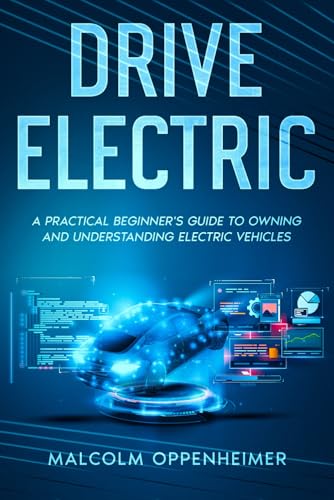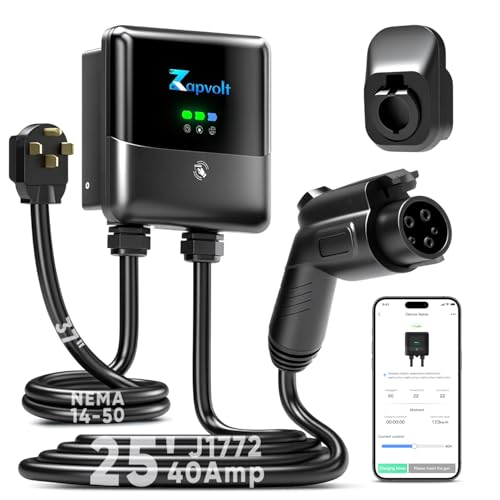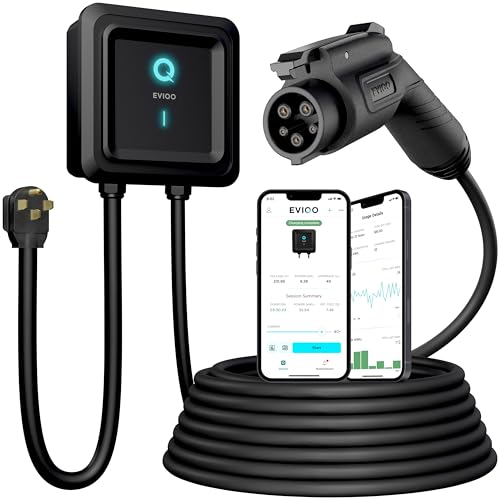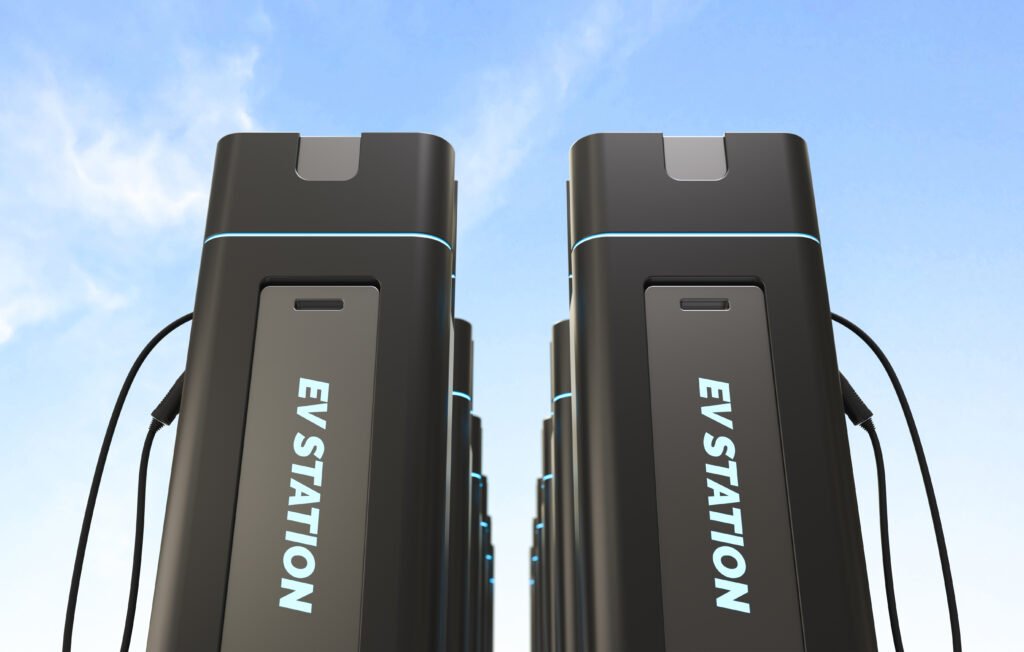
Charging Levels
EV charging is categorized into three main levels, each offering different power outputs and charging speeds. Understanding these levels is crucial for planning your charging strategy, whether you’re charging overnight at home or need a quick top-up during a road trip. The level you choose depends on your daily driving needs, available time, and electrical infrastructure. Here is your complete guide to Level 1 to DC Fast Charging.
Level 1 is the slowest but most accessible option, using standard household outlets.
Level 2 strikes the ideal balance for most EV owners, providing faster charging at home or public stations.
Level 3 (DC Fast Charging) delivers the quickest charging speeds but is only available at commercial stations and is best suited for long-distance travel rather than daily use.
Each level requires different equipment, installation considerations, and comes with varying costs. Let’s break down what each level offers and when you’d use it.
Level 1 Charging (120V AC)
- Power Output: 1.4-1.9 kW
- Charging Speed: 3-5 miles of range per hour
- Use Case: Emergency/overnight home charging
- Equipment: Standard household outlet (NEMA 5-15)
- Cable: Usually included with vehicle (EVSE cord)
Level 2 Charging (240V AC)
- Power Output: 3.3-19.2 kW (most commonly 7.2-11 kW)
- Charging Speed: 12-60 miles of range per hour
- Use Case: Primary home/workplace charging, public stations
- Installation: Requires dedicated 240V circuit
- Outlet Types: NEMA 14-50, NEMA 6-50, or hardwired
Level 3 DC Fast Charging (DCFC)
- Power Output: 50-350+ kW
- Charging Speed: 100-300+ miles in 20-30 minutes
- Use Case: Highway travel, quick public charging
- Location: Commercial stations only
ELECTRIC VEHICLES FOR BEGINNERS
Are you ready to explore the future of driving? Drive Electric is the essential guide for anyone curious about switching to electric. Designed for everyday drivers, this book covers all you need to know about EVs, from understanding how they work to reaping their environmental and financial benefits.
Starting with why electric vehicles are critical to a cleaner planet, this guide dives into the environmental impact of traditional cars and explains how EVs can help reduce pollution and support sustainability goals. Discover how EVs work, learn about battery technology, charging, and vehicle types—from fully electric to hybrids.
Plug/Connector Types
Just as different regions use different electrical outlets for household appliances, EV charging connectors vary by geography and vehicle manufacturer. Understanding which plug your vehicle uses—and which plugs are available at charging stations—is essential for ensuring compatibility and avoiding frustration on the road.
The connector landscape has evolved significantly over the past decade, with various standards competing for dominance. North America, Europe, and Asia have each developed their own preferred standards, though recent industry shifts are moving toward greater standardization. Tesla’s proprietary connector, for example, is now being adopted as the North American Charging Standard (NACS) by major automakers, potentially simplifying the charging experience for millions of drivers.
Most modern EVs can handle multiple charging types: a standard AC connector for everyday Level 1 and Level 2 charging, plus a DC fast charging connector for road trips. Some vehicles use a combined connector that handles both AC and DC, while others have separate ports. The key is knowing what your vehicle supports and what adapters you might need.
Below, we’ll explore the connector types used in each major market, their capabilities, and their current adoption status.
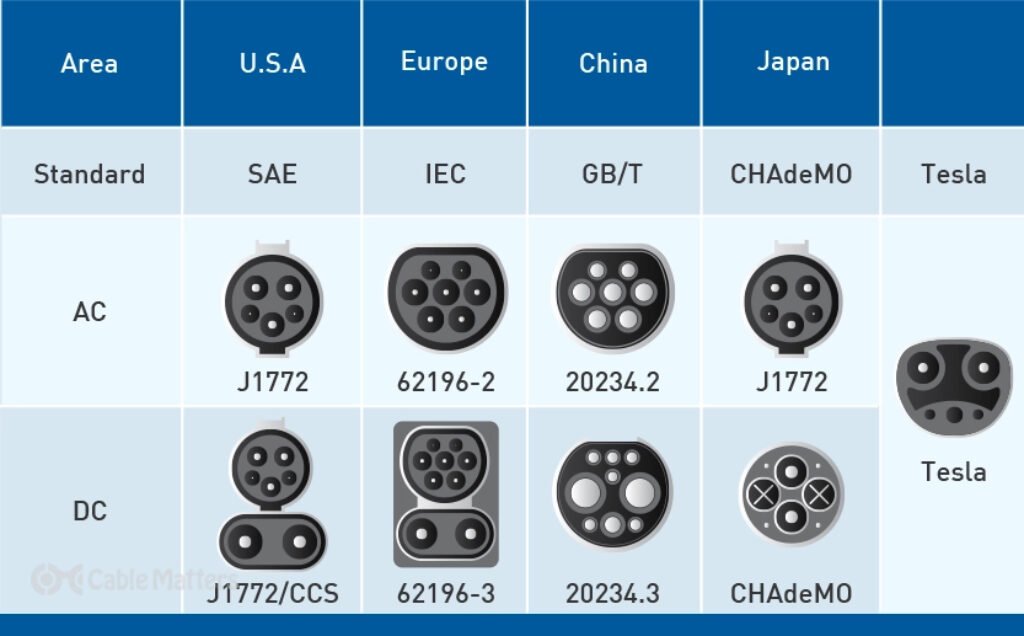
North America
J1772 (SAE J1772)
- Type: AC Level 1 & 2 Used By: All EVs in North America (except Tesla without adapter) Pins: 5-pin connector Max Power: Typically 19.2 kW Features: Communication protocol, locking mechanism
Tesla NACS (North American Charging Standard)
- Type: AC & DC combined
- Used By: Tesla vehicles (becoming industry standard)
- Max Power: 250 kW DC, 19.2 kW AC
- Status: Ford, GM, Rivian, and others adopting from 2024-2025
- Features: Compact design, combined AC/DC
CCS1 (Combined Charging System – Combo 1
- Type: DC Fast Charging
- Used By: Most non-Tesla EVs in North America
- Design: J1772 connector + 2 additional DC pins below
- Max Power: 350+ kW
- Features: Backward compatible with J1772
CHAdeMOHeading
- Type: DC Fast Charging
- Used By: Older Nissan Leaf, Mitsubishi
- Max Power: 50-100 kW (up to 400 kW in CHAdeMO 3.0)
- Status: Being phased out in favor of CCS/NACS
- Features: Bidirectional charging capability (V2G/V2H)
Europe
Type 2 (Mennekes/IEC 62196)
- Type: AC Level 2
- Used By: Standard for all EVs in Europe
- Max Power: 43 kW (three-phase)
- Pins: 7-pin connector
- Features: Three-phase charging support
CCS2 (Combined Charging System – Combo 2)
- Type: DC Fast Charging
- Used By: Most EVs in Europe
- Design: Type 2 connector + 2 additional DC pins
- Max Power: 350+ kW Features: Dominant fast charging standard in Europe
CHAdeMO
- Type: DC Fast Charging
- Status: Less common in Europe, being phased out
China
GB/T (Guobiao)
- GB/T 20234.2: AC charging (similar to Type 2)
- GB/T 20234.3: DC fast charging
- Used By: All EVs sold in China
- Features: Mandatory standard for Chinese market
Cable Types & Configurations
Beyond the plug itself, the cable and its configuration play a critical role in how EVs charge safely and efficiently. EV charging cables aren’t just simple power cords—they contain sophisticated communication systems that allow your vehicle and the charging station to “talk” to each other, negotiating power levels, monitoring safety, and managing the charging session.
The International Electrotechnical Commission (IEC) has defined four “modes” of EV charging, each representing different levels of communication, control, and safety features. These modes determine whether the cable is permanently attached to the charging station or something you carry with you, and how the charging process is controlled and monitored.
Understanding cable modes helps explain why some charging stations have tethered cables while others require you to bring your own, why DC fast chargers always have attached cables, and why that portable charger that came with your vehicle has a bulky control box in the middle of it.
The cable configuration you’ll encounter depends on where you’re charging—at home with a portable unit, at a public Level 2 station, or at a DC fast charging station. Each scenario uses different cable types optimized for that specific use case.
Mode 2 Cables
- Portable EVSE with in-cable control box
- Plugs into standard household outlet
- Level 1 charging
- Usually comes with vehicle
Mode 3 Cables
- For Level 2 AC charging
- Type 1: Permanently attached to charging station OR
- Type 2: Detachable cable (user provides or station provides)
- Communication between vehicle and charger
Mode 4 Cables
- DC Fast Charging
- Always permanently attached to charging station
- Heavy-duty cooling systems in cable
- No user-supplied cables
Home Charging Solutions
For most EV owners, home charging is where the magic happens. Unlike conventional vehicles that require trips to gas stations, EVs offer the convenience of “refueling” while you sleep, work from home, or go about your daily routine. Waking up to a fully charged vehicle every morning is one of the most appreciated benefits of EV ownership—but achieving this requires choosing the right home charging solution for your needs.
Home charging options range from simple portable units that plug into existing outlets to sophisticated hardwired wall-mounted stations with smart features and app control. The right choice depends on several factors: your vehicle’s charging capabilities, your daily driving distance, your home’s electrical capacity, your budget, and whether you want basic functionality or advanced features like scheduling, energy monitoring, and integration with solar panels or home energy systems.
The good news is that most EV owners don’t need the fastest possible charging at home. Since your vehicle sits parked for hours overnight, even a modest Level 2 charger can fully replenish your battery by morning. However, investing in higher-capacity equipment now can future-proof your setup for faster-charging EVs down the road or accommodate multiple vehicles.
- 【Fast Charging for Home】Level 2 40-amp EV Smart Charger reaches up to 8x the speed of competitors’ chargers. Boosted by …
- 【Compatible Design】Your Smart Charger supports a wide range of charging currents and includes a SAE J1772 plug. Innovati…
- 【APP and Energy Saving】Easily set up to three schedules and monitor your charging status with our U-Charger Smart APP. S…
- 【Fast 40A Level 2 EV Charger】Portable and as fast as a hardwired electric car charger. delivering 9.6kW and up to 37 mi/…
- 【Reliable Safety with PBE & LCR Tech】Powered by ELEGRP’s exclusive PBE technology, this charger offers full protection a…
- 【Certified Quality, Guaranteed Support】Fully ETL certified for safety and quality. UL-listed J1772 plug, cable, and NEMA…
- 9X FASTER: EVIQO is home car charging station providing 38 m/h (40 amp ev charger by default) and 46 m/h if hardwired an…
- SAFE, USA CERTIFIED: Level 2 charger EVIQO electric car charger level 2 is UL compliant, Energy Star, ETL and FCC certif…
- SMART APP: EVIQO EV mobile charger surveyed 1,800 EV owners to create type 2 ev charger home charger level 2 app. Set up…
Let’s explore the different types of home charging equipment available and what each offers.
Portable/Mobile EVSE
- Plugs into existing outlets
- 120V or 240V options
- Adjustable amperage (16-40A typical)
- Interchangeable plugs (NEMA 5-15, 14-50, 6-50)
- Cost: $300-$700
Wall-Mounted Charging Stations
- Hardwired or plug-in (NEMA 14-50)
- WiFi connectivity and apps
- Load management features
- 32-48 amp capability
- Cost: $400-$1,200+

Smart Chargers
- Time-of-use scheduling
- Energy monitoring
- Grid integration
- Solar integration
- Voice control (Alexa, Google)
💡 Home EV Charging Made Easy: Why You Need a Smart EV Charger in 2025
Power Requirements & Circuit Sizing
Installing home EV charging equipment isn’t as simple as plugging in an appliance—it requires careful consideration of your home’s electrical capacity and proper circuit sizing to ensure safe, efficient operation. Understanding the relationship between charger power, amperage, circuit breakers, and wire gauge is essential whether you’re planning a DIY installation or working with an electrician.
The fundamental principle is straightforward: more power means faster charging, but it also requires larger electrical infrastructure. A basic 16-amp charger can use a relatively simple 20-amp circuit, while a high-powered 48-amp charger demands a robust 60-amp circuit with heavier gauge wiring. The National Electrical Code (NEC) requires that continuous loads like EV chargers be sized at 125% of their rated capacity, which is why a 40-amp charger needs a 50-amp breaker rather than a 40-amp one.
Before selecting a charging station, you’ll need to assess your home’s available electrical capacity. Many homes have 100-200 amp main service panels, and adding an EV charger means accounting for all your other electrical loads—HVAC systems, water heaters, kitchen appliances, and more. Some homes may need panel upgrades, while others can accommodate EV charging with load management systems that intelligently balance power distribution.
The table below provides a quick reference for matching charger power levels to the required electrical infrastructure, helping you plan your installation and discuss requirements with your electrician.
| Charger Power | Amperage | Circuit Breaker | Wire Gauge |
|---|---|---|---|
| 3.3 kW | 16A | 20A | 12 AWG |
| 7.2 kW | 32A | 40A | 8 AWG |
| 9.6 kW | 40A | 50A | 6 AWG |
| 11.5 kW | 48A | 60A | 6 AWG |
| 19.2 kW | 80A | 100A | 3 AWG |
Note: Requires 125% capacity (NEC code)
Adapters
Common Adapters
- Tesla to J1772: Allows Tesla to charge at J1772 stations
- J1772 to Tesla: Allows non-Tesla to charge at Tesla destination chargers (limited availability)
- NACS adapters: Ford, GM, Rivian providing adapters for CCS1 vehicles to use Tesla Superchargers
- CHAdeMO to CCS: Rare, not recommended
- Outlet adapters: NEMA 14-50 to various other outlet types
Charging Networks & Access
Major Networks (North America)
- Tesla Supercharger (NACS, opening to others)
- Electrify America (CCS1, CHAdeMO)
- EVgo (CCS1, CHAdeMO)
- ChargePoint (J1772, CCS1)
- Flo
- Blink
Payment Methods
- Network mobile apps
- RFID cards
- Plug & Charge (automatic billing)
- Credit card readers (increasingly required)
Bidirectional Charging
Until recently, EV charging was a one-way street: electricity flowed from the grid into your vehicle’s battery. But bidirectional charging is transforming EVs from mere transportation devices into mobile energy storage units that can power your home, support the electrical grid, or run your tools and appliances wherever you go.
The concept is elegantly simple: your EV’s battery—typically holding 60-100+ kWh of energy—can serve as a massive backup power source. To put that in perspective, the average American home uses about 30 kWh per day, meaning a single EV battery could power an entire house for two to three days during an outage. Beyond emergency backup, bidirectional charging enables economic benefits like selling power back to the grid during peak demand periods, environmental benefits by supporting renewable energy integration, and practical benefits like powering job sites or camping equipment.
However, bidirectional charging isn’t yet universal. It requires three key components: a vehicle with bidirectional capability, a compatible bidirectional charger or inverter, and in some cases, additional equipment like transfer switches for home integration. The technology is rapidly evolving, with more automakers adding support and various standards competing for adoption.
There are three main categories of bidirectional charging, each serving different purposes and use cases.
Vehicle-to-Grid (V2G)
- Send power back to grid
- Requires compatible vehicle and charger
- CHAdeMO native support, CCS adding support
Vehicle-to-Home (V2H)
- Backup power for home
- Requires transfer switch
- Ford F-150 Lightning, Nissan Leaf capable
Vehicle-to-Load (V2L)
- Power devices/tools from vehicle
- Built-in outlets (Hyundai Ioniq 5, Rivian, F-150 Lightning)
Key Considerations
With so many charging options, connector types, and technical specifications to navigate, making the right choices for your EV charging setup can feel overwhelming. However, by focusing on a few critical factors—tailored to your specific situation—you can cut through the complexity and make informed decisions that will serve you well for years to come.
The key is to think holistically about your needs rather than fixating on a single aspect like maximum charging speed or lowest upfront cost. Your ideal home charging solution depends on your vehicle’s capabilities, your daily driving patterns, your home’s electrical infrastructure, and your long-term plans. Similarly, successful road trip charging requires understanding not just where chargers are located, but which networks you can access, what speeds they offer, and whether you need adapters.
It’s also worth thinking beyond your immediate needs. EVs and charging technology are evolving rapidly—vehicles are gaining faster charging capabilities, new connector standards are emerging, and charging networks are expanding. Decisions made today, particularly for permanent home installations, should account for these trends to avoid costly upgrades down the road.
Below are the essential considerations broken down by the two most common scenarios EV owners face: setting up home charging and planning for long-distance travel.
When Choosing Home Charging:
- Vehicle’s maximum AC charging rate
- Available electrical capacity
- Installation costs
- Smart features needed
- Future-proofing (higher amperage)
When Road Tripping:
- Check plug compatibility
- Plan route with charging networks
- Understand charging speeds
- Have backup options
- Consider adapter needs
Safety Features:
- Ground fault protection (GFCI)
- Overcurrent protection
- Temperature monitoring
- Locking connectors
- Weatherproofing (outdoor use)
Charging Your Way Forward
The world of EV charging may seem complex at first glance, with its various levels, connectors, and configurations, but it quickly becomes second nature once you understand the fundamentals. Whether you’re charging at home overnight, topping up at work, or fast-charging on a cross-country road trip, the infrastructure is rapidly expanding and improving to make EV ownership more convenient than ever.
The most important takeaway is this: there’s no single “right” charging solution for everyone. Your ideal setup depends on your vehicle, your driving habits, your home’s electrical capacity, and your budget. Start with what meets your immediate needs, but don’t hesitate to invest in flexibility and future-proofing where it makes sense.
As the EV market matures and standards continue to consolidate—particularly with the adoption of NACS in North America—charging will only become simpler and more accessible. The transition away from fossil fuels is well underway, and understanding how to keep your EV charged is your gateway to cleaner, more convenient transportation.
Ready to make the switch? Armed with this knowledge, you’re now equipped to choose the right charging solutions and confidently navigate the electric vehicle ecosystem.
Welcome to the future of driving.


